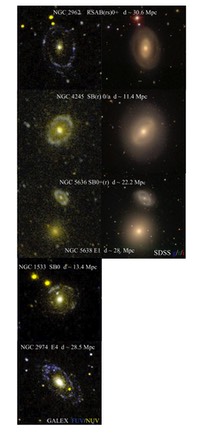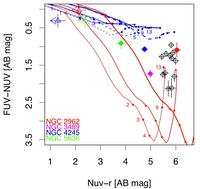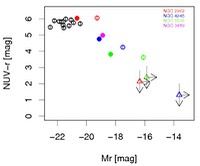S0s galaxies have been introduced by Hubble (1936) in his "tuning fork" galaxy classification as a more or less hypothetical transition class between ellipticals and spirals. The bulge and the disk are the defining structures of S0s. Later classification schemes by de Vaucouleurs et al. (1991, RC3) and Sandage & Tammann (1987, RSA) take into account the presence of several sub-structures detected within the S0s class: bars, inner and outer rings as well as lenses (from here the widely used term of lenticulars as synonim of S0s) and ovals are often found.
S0s are, as a rule, admitted in the vast class of early-type galaxies, together with ellipticals, with which they share typically passively evolving stellar populations.
From an evolutionary point of view it is widely believed that S0s were initially spirals which lost their interstellar medium during collisions (Spitzer and Baade 1951) by "harassment" (More et al. 1986) or by "ram-pressure". Simulations shows that such events could occur both in cluster (Gunn and Gott 1972) and in groups (see e.g. Bekki 2009).
From the kinematical point of view, genuine S0s are quite distinct from giant ellipticals since they are fast rotating, like late-type galaxies. At the same time, if S0s were originally spirals, they should have formed their mass over a significant fraction of the Hubble time, following a star fromation history more similar to that of early-type galaxies rather than that of giant elliptical galaxies. In this context, our multi-wavelength study of nearby ETGs (Marino et al. 2010) shows that S0s, chracterized through their luminosity profiles and by the low values of the Sersic index (Sersic 1968), have the lowest values of a-enhancements [a/Fe] in the sample. The low [a/Fe] suggest a "more prolonged" star fromation in the S0 galaxies with respect to ellipticals in the sample (Annibali et al. 2007; Annibali et al. 2010).
Several mechanisms, both internal and external to the galaxy, may be envisaged to produce the signature of a "prolonged" star formation. The removal of the ISM from a possible spiral precursor may quench the ongoing star formation transforming the debris in a S0 with signature of prolonged star formation, as well as an external wet accretion and/or the inner secular evolution, e.g. driven by a tumbling bar (see e.g. van den Bosch and Emsellem 1998).
The Galaxy Evolution Explorer satellite (GALEX) has widely contributed to explore the above mechanisms. "Wet" accretions, and the rejuvenation of the stellar population, has been evidenced in ETGs (see e.g. Rampazzo et al. 2007 and Marino et al. 2009). Recently, Thilker et al. (2010) found in NGC 404, a nearby well known S0, an external ring-like structure with signatures of recent star formation. The structure has been likely produced by a "wet accretion accretion/merger"
We used GALEX for analyzing five S0s showing outer ring and/or arm-like structures aiming at understanding the nature of the ring and to map possible star formation episodes. Such structures are prominent in the UV and reveal recent star formation. We quantitatively characterize these rejuvenation events, estimating the average age and stellar mass of the ring structure as well as of the entire galaxy. The mass fraction of the UV-bright rings is a few percent of the total galaxy mass, although the UV ring luminosity reaches 70% of the galaxy luminosity. The integrated colors of these S0s locates them in the red sequence (NGC 2962) and in the so-called "green valley". We suggest that the star formation episodes may induced by different triggering mechanisms, such a the inner secular evolution driven by bars, and interaction episodes.
more details in
Marino A., Bianchi, L., Rampazzo R., Thilker, D., Annibali F.,
Bressan, A. and Buson L.M.
Signature of recent star formation in ring S0 galaxies
2011, ``UV Universe 2010", Ap&SS, 249
Marino A., Bianchi, L., Rampazzo R., Thilker, D., Annibali F.,
Bressan, A. and Buson L.M.
Tracing rejuvenation events in nearby S0 galaxies
2011, ApJ, 736, 154
Rampazzo R., Annibali F., Marino A., Bianchi, L., Bressan, A., Buson L.M.,
Clemens M.S., Panuzzo, P. and Zeilinger W.W.
Tracing the evolution of nearby-early-type galaxies in low density environments.
The Ultraviolet view from GALEX
2011, ``UV Universe 2010", Ap&SS, 251


